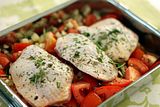
Christine of "Happy Tummy" picked Great Grains Muffins for us this week. It's just what I feel like - I have been baking and eating a lot of really sugary stuff lately so muffins are just the thing. If you would like the recipe it's on Christine's blog, here.
I don't usually bake with prunes (mostly raisins or currants) but I had a nice can of moist prunes so why not use it? I will probably tell my office team that the fruit is plums - if I say prunes they might start thinking about Activa yoghurt or senna pods - I mean, prunes are plums, aren't they, just dried a little bit, so I won't really be misleading them.
Easy to come together, easy to bake. They have risen nicely and took exactly 20 minutes to pass the doneness test. Tomorrow will tell if they are successful or not.
The next day: Some of my group really enjoyed the muffins, but on the whole they were not a rave. I thought they were quite good but not as good as other TWD muffins I have baked. However, they are really moist and not too sweet, and go well with a cup of morning coffee.

























.jpg)




